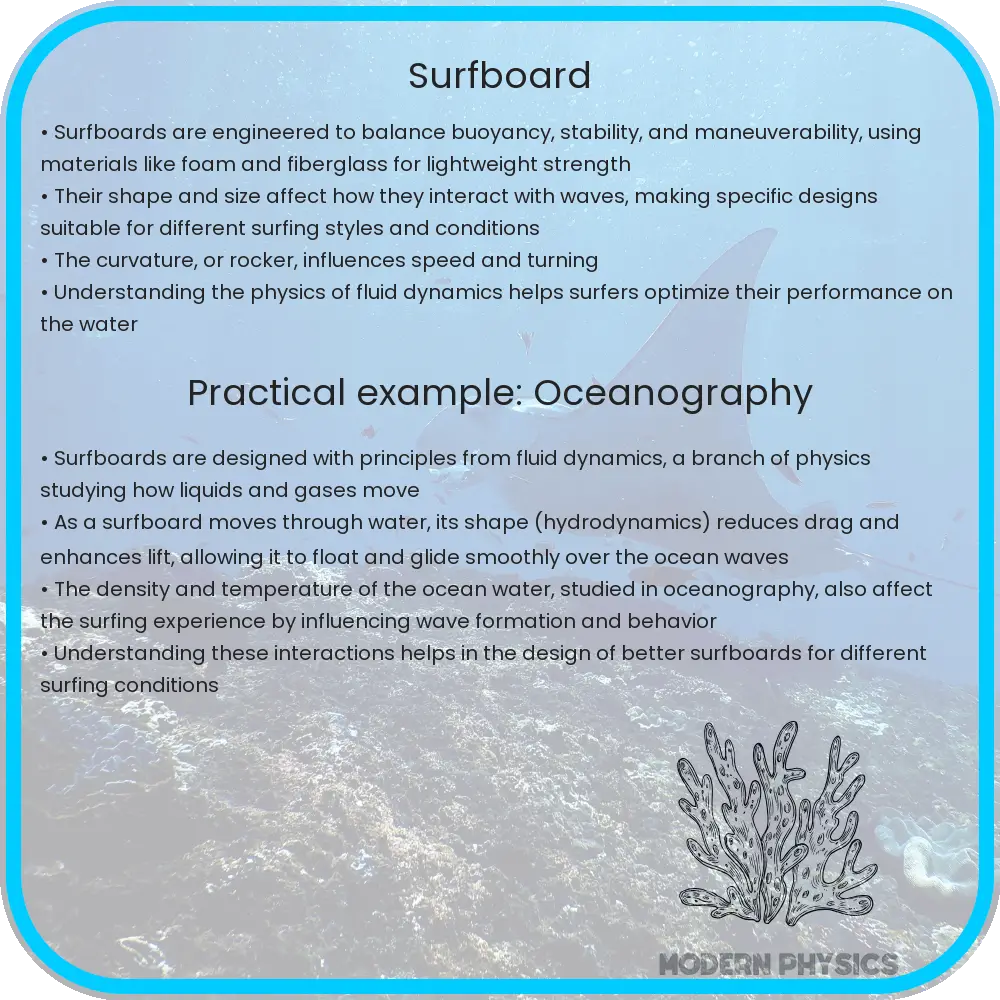Explore the physics of surfboard kinematics and wave dynamics, delving into control mechanics, board design, and future sustainable surfing trends.

Understanding Surfboard Kinematics and Wave Dynamics
The fascinating world of surfboard kinematics intertwines closely with the physics of wave dynamics, presenting a unique blend of control and fluid mechanics. To grasp this interaction, it’s crucial to first understand the basic principles of wave dynamics and how they influence surfboard movement.
Wave Dynamics: The Ocean’s Rhythmic Patterns
Waves are formed by the wind’s energy transferring to the water, creating a force that pushes the water upwards. The size and strength of these waves depend on wind speed, water depth, and the distance over which the wind interacts with the ocean’s surface, known as the fetch. This dynamic creates varying wave types, each presenting unique challenges and opportunities for surfers.
Surfboard Kinematics: The Science of Movement on Waves
Surfboard kinematics is the study of the motion of surfboards on waves. It involves understanding the forces at play, such as gravity, buoyancy, and drag, and how surfers use their body weight and balance to control their boards. The design of the surfboard, including its shape, size, and fin configuration, significantly influences its movement and stability.
Control Mechanics: Mastering the Art of Surfing
Control in surfing is about managing these forces and the surfboard’s response to them. Skilled surfers read wave patterns, anticipate changes, and adjust their position and weight distribution accordingly. This process requires a keen understanding of physics and a high level of physical coordination.
The Physics of Surfing: An Interplay of Forces
When a surfer catches a wave, they tap into the wave’s energy, allowing the wave to propel them forward. The surfer’s velocity needs to match the wave’s speed to maintain balance and control. This equilibrium involves calculating the gravitational force pulling the surfer down the wave’s face, the buoyant force keeping the surfboard afloat, and the hydrodynamic drag that resists the board’s motion through water.
These forces are represented by the following equations:
- Gravitational Force (Fg): Fg = m × g, where m is the mass of the surfer and board, and g is the acceleration due to gravity.
- Buoyant Force (Fb): Fb = ρ × V × g, where ρ is the density of water, V is the submerged volume of the board, and g is the acceleration due to gravity.
- Hydrodynamic Drag (Fd): Fd = ½ × ρ × A × Cd × v2, where ρ is the density of water, A is the cross-sectional area of the board, Cd is the drag coefficient, and v is the velocity of the board relative to water.
These equations are fundamental to understanding the physics behind surfing and are essential for designing surfboards that optimize performance under different wave conditions.
Advanced Surfboard Design: Tailoring to Wave Conditions
The design of a surfboard significantly impacts its performance. Factors such as length, width, thickness, and curvature (known as rocker) are tailored to specific wave types and surfing styles. For instance, longer boards with less rocker are ideal for gliding on smaller, softer waves, while shorter boards with more rocker are better suited for steep, fast-breaking waves.
Materials and Technology: Enhancing Performance
Advancements in materials science have revolutionized surfboard manufacturing. Materials like expanded polystyrene (EPS) foam, epoxy resins, and carbon fiber composites provide a balance of strength, flexibility, and lightness, enhancing wave riding experience. Computational fluid dynamics (CFD) software also aids in optimizing board designs for specific wave conditions and surfing styles.
Environmental Impact and Sustainability
As surfing grows in popularity, its environmental impact cannot be ignored. Traditional surfboard manufacturing involves materials that are often non-recyclable and harmful to the environment. The surfing community is increasingly embracing eco-friendly materials and sustainable practices, such as using recycled foam cores and bio-based resins.
Future Trends in Surfboard Kinematics
The future of surfboard design lies in further integrating technology with traditional shaping skills. Innovations like adjustable fins, electronic control systems for stability, and smart boards equipped with sensors to analyze wave conditions and performance are on the horizon. These advancements will enable surfers to adapt their boards in real-time to changing wave conditions, pushing the boundaries of what is possible in the sport.
Conclusion
The interplay between surfboard kinematics and wave dynamics is a rich field that combines elements of physics, engineering, environmental science, and athleticism. Understanding the fundamental forces at play helps in appreciating the intricacies of surfboard design and the skill involved in surfing. As technology advances, we can expect more innovative and sustainable surfboard designs that enhance performance while minimizing environmental impact. Whether for professional athletes or recreational surfers, the ongoing evolution in surfboard kinematics promises an exciting future for this thrilling sport.
